Research on the Bearing Characteristics of Folding Steel Arch Frames with Different Snap-Fit Types Based on the Compensation Excavation Concept
Abstract
1. Introduction
2. Snap-Fit Folding Steel Arch Frames for Tunnels
2.1. Folding Steel Arch Frames for Machining Arch Frame Erection in Tunnels
2.2. Connection Methods for Folding Steel Arch Frames
2.3. Types of Snap-Fit Connection
3. Analysis of Mechanical Performance of Folding Steel Arch Frames with Different Snap-Fit Types
3.1. Numerical Calculation Model Building
3.2. Numerical Model Parameters
3.3. Simulation Results Analysis
3.3.1. Displacement Characteristics of the Folding Steel Arch Frame
3.3.2. Stress Characteristics of the Folding Steel Arch Frame
3.3.3. Stress Characteristics of Joints
3.3.4. Contact Status Analysis of Connecting Plates
4. Engineering Application and Verification
4.1. Project Overview
4.2. Result Analysis
5. Recommendations
6. Conclusions
- The maximum vertical displacements of A- and B-type snap-fit connections decrease and then increase with increasing joint diameter. With a joint diameter of 20 mm, the minimum displacements are 43.1 mm and 39.2 mm, respectively, for A- and B-type snap-fit connections. The vertical displacement of the B-type snap-fit is reduced by 9.1% compared to the A-type snap-fit, indicating that the B-type snap-fit has stronger anti-deformation capacity and greater load-bearing performance.
- The maximum principal stress of the B-type folding steel arch frames is 49.3 MPa, which is 4.5% lower than that of the A-type folding steel arch frames (51.6 MPa).
- The field test results indicate that for the same joint diameter, the maximum stress of the B-type folding steel arch frames is reduced by 15.8% compared to the A-type folding steel arch frames, significantly improving their ability to compensate for rock deformation. This makes the B-type snap-fit a more suitable form of connection for folding steel arch frames in tunnels and facilitates the development and application of mechanized installation technologies for steel arch frames in tunnels.
Author Contributions
Funding
Data Availability Statement
Acknowledgments
Conflicts of Interest
References
- China Civil Engineering Society. Report on Advance in Tunnel and Underground Engineering; Science and Technology of China Press: Beijing, China, 2020. [Google Scholar]
- Qian, Q.H.; Lin, P. Safety risk management of underground engineering in China: Progress, challenges and strategies. J. Rock Mech. Geotech. Eng. 2016, 8, 423–442. [Google Scholar] [CrossRef]
- Guo, D.S.; Song, Z.P.; Xu, T.; Zhang, Y.W.; Ding, L.B. Coupling analysis of tunnel construction risk in complex geology and construction factors. J. Constr. Eng. Manag. 2022, 148, 04022097. [Google Scholar] [CrossRef]
- Gong, J.F.; Wang, W.; Li, X.; Zhu, Y. Statistics of railway tunnels in China by the end of 2022 and overview of key tunnels of projects newly put into operation in 2022. Tunn. Constr. 2023, 43, 721. [Google Scholar]
- Wang, Q.S. Some thoughts on development of drilling-and-blasting construction technology for mountain tunnels in China. Tunn. Constr. 2023, 43, 37–45. [Google Scholar]
- Wang, Q.; Qin, Q.; Jiang, B.; Xu, S.; Zeng, Z.N.; Luan, Y.C.; Liu, B.H.; Zhang, H.J. Mechanized construction of fabricated arches for large-diameter tunnels. Autom. Constr. 2021, 124, 103583. [Google Scholar] [CrossRef]
- He, Y.F.; Yang, M.; Xu, Z.; Li, S.Y.; Zhang, B.W. Design of tunnel steel arch looping manipulator with multiple actuators in limited space. Sci. Prog. 2023, 106, 368504231180025. [Google Scholar] [CrossRef]
- Tao, Z.G.; Xie, D.; Sui, Q.R.; Sun, J.H.; He, M.C. Study on active support method and control effect of NPR anchor cables for large deformation of tunnel surrounding rock under complex geological conditions. Chin. J. Rock Mech. Eng. 2024, 43, 275–286. [Google Scholar]
- Sui, M.C.H.Q.R.; Tao, Z.G. Excavation compensation theory and supplementary technology system for large deformation disasters. Deep. Undergr. Sci. Eng. 2023, 2, 105–128. [Google Scholar] [CrossRef]
- Guo, L.J.; Tao, Z.G.; He, M.C.; Coli, M. Excavation compensation and bolt support for a deep mine drift. J. Rock Mech. Geotech. Eng. 2024, 16, 3206–3220. [Google Scholar] [CrossRef]
- Guo, J.B.; Chen, J.; Liu, J.Z.; Niu, J.C. Multifunctional integration equipment design and construction technology research. Adv. Mater. Res. 2013, 650, 359–363. [Google Scholar] [CrossRef]
- Cheng, Y. The Research of Trajectory Planning for Manipulator of SGDC700 Tunnel Arch Multi-Function Installing Truck. Master’s Thesis, Xiangtan University, Xiangtan, China, 2015. [Google Scholar]
- Wang, Q. Control Theory and Engineering Practice of Confined Concrete in Underground Engineering; Science Press: Beijing, China, 2019. [Google Scholar]
- Liu, F.X. SCDZ133 intelligent multi-function trolley and its application in tunneling. Mod. Tunn. Technol. 2019, 56, 1–7. [Google Scholar]
- Sun, H.L. Study on Stability Bearing Mechanism and Key Technologies of Assembly Confined Concrete Support for Large Section Tunnel. Master’s Thesis, Shandong University, Jinan, China, 2020. [Google Scholar]
- He, Y.F.; Xia, Y.M.; Long, B.; Deng, Z.H.; Lei, M.L.; Yao, J. Grasping docking mechanism of TBM steel arch splicing robot. J. Zhejiang Univ. (Eng. Sci.) 2021, 54, 2204–2213. [Google Scholar]
- Zhao, Y. Subsidiary technology for rapid construction of multifunctional steel arch erection machine in Yuelongmen tunnel. Railw. Constr. Technol. 2020, 2, 96–98+132. [Google Scholar]
- Yan, Q. A remote unmanned construction system for steel arch erection developed by Japan Toda Construction Corporation. Tunn. Constr. 2021, 41, 387. [Google Scholar]
- Krauze, K.; Boloz, L.; Mucha, K.; Wydro, T. The mechanized supporting system in tunnelling operations. Tunn. Undergr. Space 2021, 113, 103929. [Google Scholar] [CrossRef]
- Ni, P.L. Research and application of new type of tunnel supporting equipment, steel arch installation trolley. China Plant Eng. 2020, 18, 12–13. (In Chinese) [Google Scholar]
- Sun, C.Z.; Miao, C.Q.; Li, A.Q.; Qian, Y. Finite element analysis of mechanical properties of pile cap connections for prestressed concrete solid pile using snap-in mechanical connection. J. Disaster Prev. Mitig. Eng. 2019, 39, 37–44. [Google Scholar]
- Wang, J.B. Numerical Simulation of Bending and Large Deformation Retractable Steel Arch Frame Support in Layered Soft Rock Tunnel. Master’s Thesis, Chengdu University of Technology, Chengdu, China, 2020. [Google Scholar]
- Li, W.T.; Yang, N.; Mei, Y.C.; Zhang, Y.H.; Wang, L.; Ma, H.Y. Experimental investigation of the compression-bending property of the casing joints in a concrete filled steel tubular supporting arch for tunnel engineering. Tunn. Undergr. Space Technol. 2020, 96, 103184. [Google Scholar] [CrossRef]
- Xu, F.; Li, S.C.; Zhang, Q.Q.; Li, L.P.; Shi, S.S.; Zhang, Q. A new type support structure in-troduction and its contrast study with traditional support structure used in tunnel construction. Tunn. Undergr. Space Technol. 2017, 63, 171–182. [Google Scholar] [CrossRef]
- Ma, K.M.; Zhang, J.C.; Zhang, J.R.; Wang, Z.Y.; Feng, J.M. Longitudinal connection effect on initial support steel frames in tunnels—Take the traffic tunnels as examples. Undergr. Space 2022, 7, 608–622. [Google Scholar] [CrossRef]
- Song, Q.Y.; Heidarpour, A.; Zhao, X.L.; Han, L.H. Performance of flange-welded/web-bolted steel I-beam to hollow tubular column connections under seismic load. Thin Walled Struct. 2017, 116, 250–264. [Google Scholar] [CrossRef]
- Yue, G.Z. Some suggestions on the connection of steel arch frame in tunnel construction. J. Shandong Ind. Technol. 2015, 23, 86–87. (In Chinese) [Google Scholar] [CrossRef]
- Li, G.A.; Wang, Y.D.; Nie, Y.W.; Wan, S.T.; Wang, C.Y. Study on longitudinal connection support structure of steel plate between steel arches of soft rock tunnel. Highway 2022, 67, 411–418. (In Chinese) [Google Scholar]
- He, M.C.; Wang, B.; Tao, Z.G.; Qiao, Y.F.; Xiao, Y.M. Axial compression behavior of adaptive steel arch joint for large deformation tunnels. China J. Highw. Transp. 2021, 34, 1–10. [Google Scholar]
- Zhang, G.W.; Li, D.W.; Lei, X.T. Folding steel arch frame applicable to mechanized construction of tunnels and its key techniques. Tunn. Constr. 2022, 42, 445–450. [Google Scholar]
- Zhang, G.W. Study on Mechanical Effect of Connection Mode Between Segments of Steel Arch Frame Suitable for Unmanned Installation. Master’s Thesis, Lanzhou Jiaotong University, Lanzhou, China, 2022. [Google Scholar]
- Wu, Y.M.; Tian, C.Q.; Xu, P.; Zhao, Z.Z.; Zhang, J.W.; Wang, S.J. Design optimization method of feet-lock steel pipe for soft-rock tunnel based on load-deformation coordination. Appl. Sci. 2022, 12, 3866. [Google Scholar] [CrossRef]
- Huang, C.F.; Li, S.H.; Li, D.W.; Li, W.B.; Yao, T.J.; Xiao, Y. Mechanical properties of folding arch frame joints for unmanned arch erection. Buildings 2024, 14, 1480. [Google Scholar] [CrossRef]
- Liu, Z.Y.; Tang, Q.S.; Dong, X.Y.; Weng, W.S.; Zhao, J.X.; Zhang, J.M. Experimental study on performance of the connection joints of cold-formed square steel tubular columns and H-shaped steel beams extension endplate using blind bolts. Build. Struct. 2021, 51, 57–63. [Google Scholar]
- Wang, H.; Zheng, P.Q.; Zhao, W.J.; Tian, H.M. Application of a combined supporting technology with U-shaped steel support and anchor-grouting to surrounding soft rock reinforcement in roadway. J. Cent. South Univ. 2018, 25, 1240–1250. [Google Scholar] [CrossRef]
- TB 10003-2016; Code for Design of Railway Tunnel. Ministry of Railways: Beijing, China, 2016.

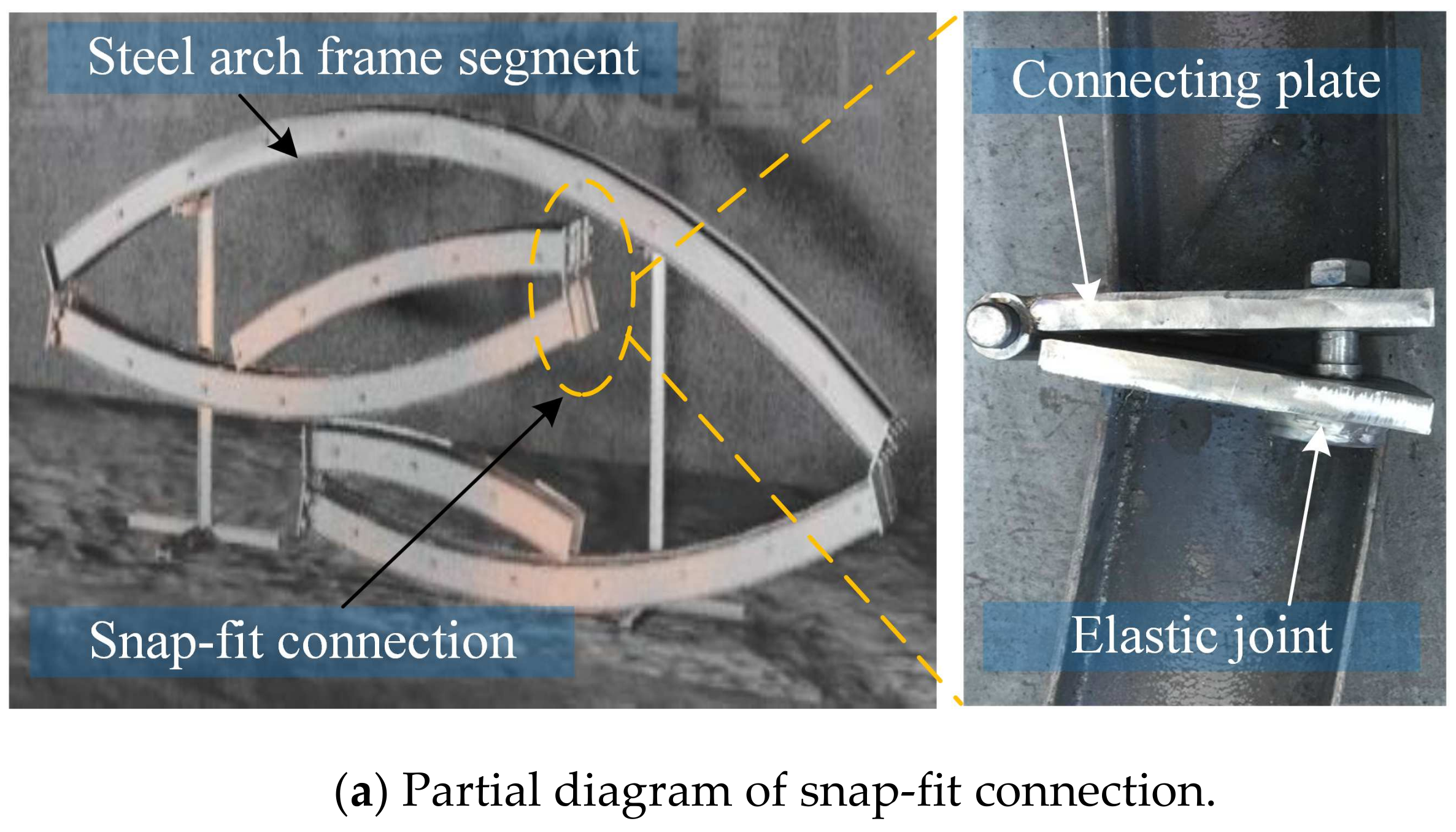
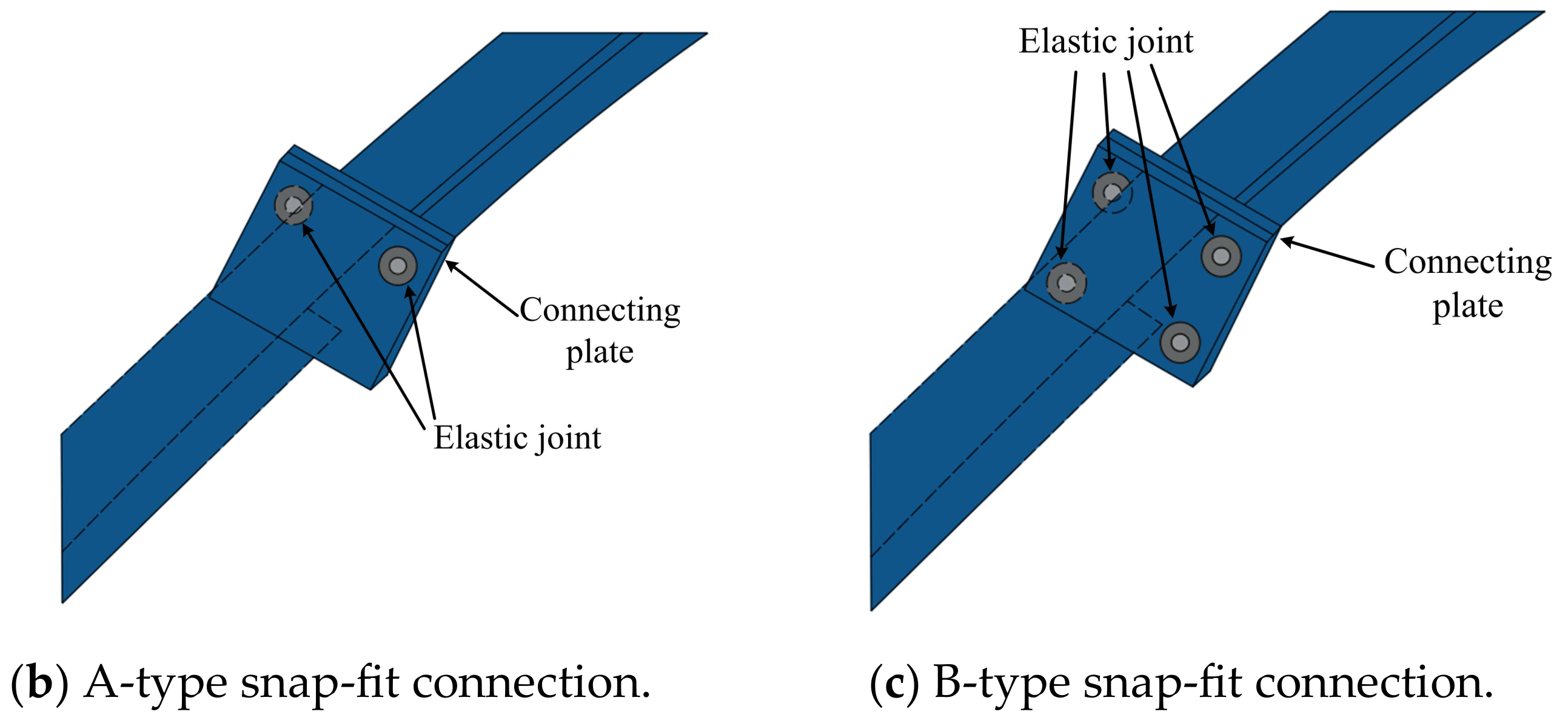

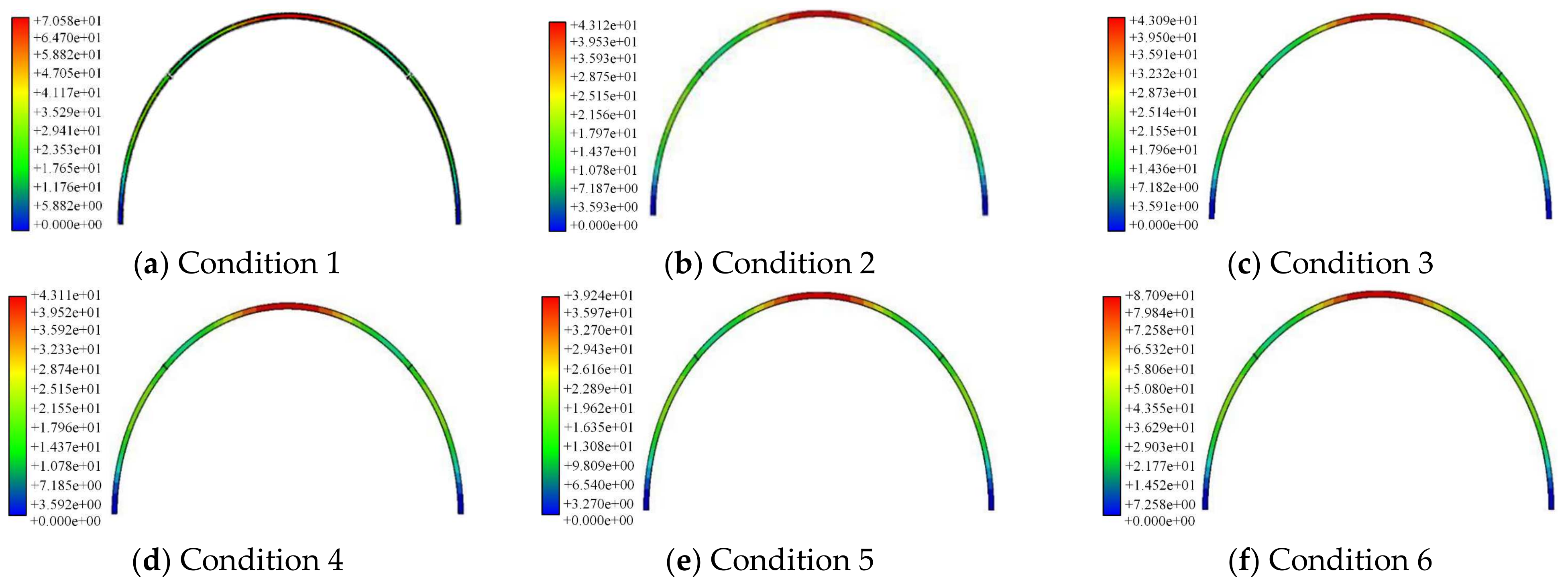
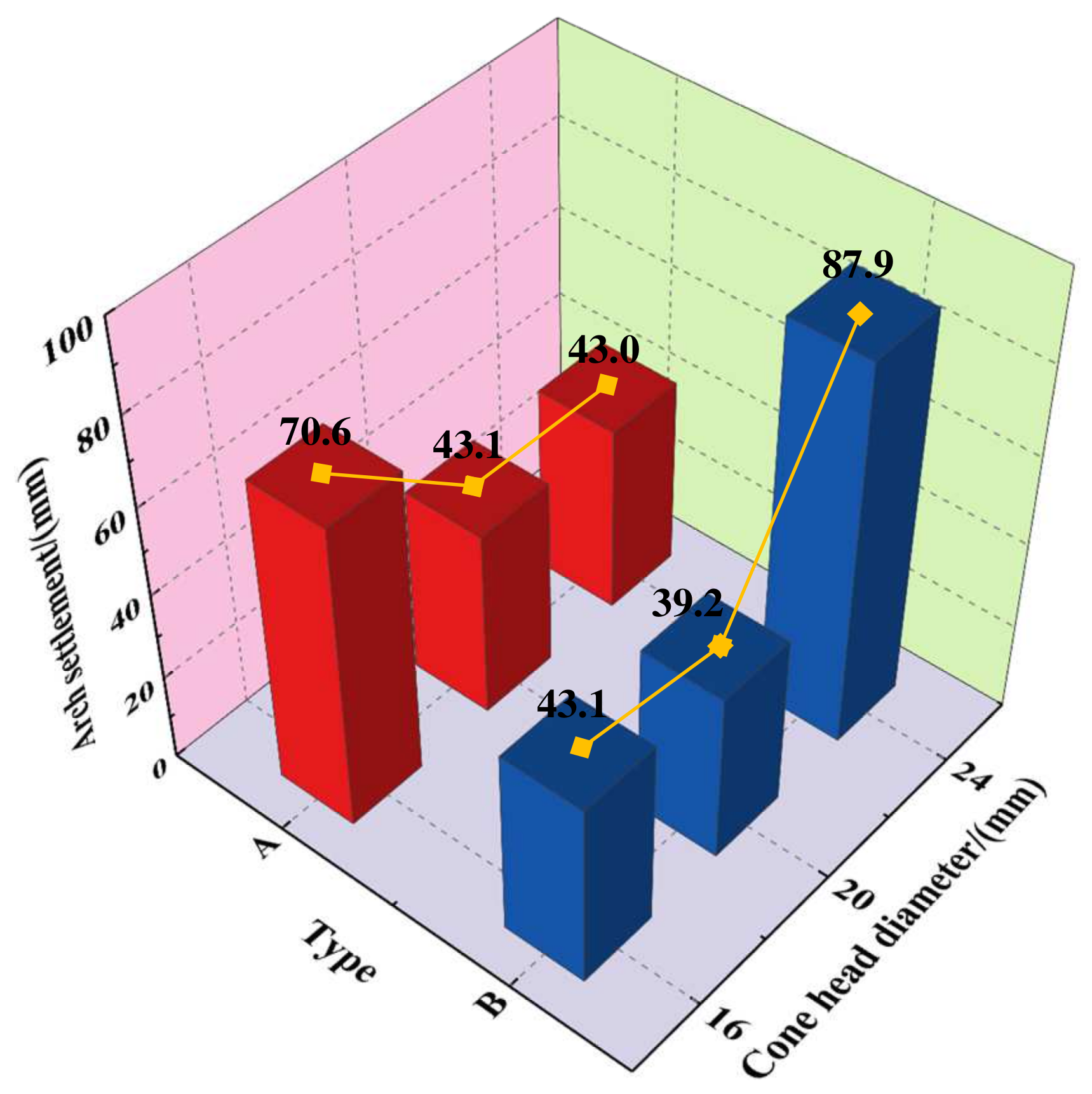
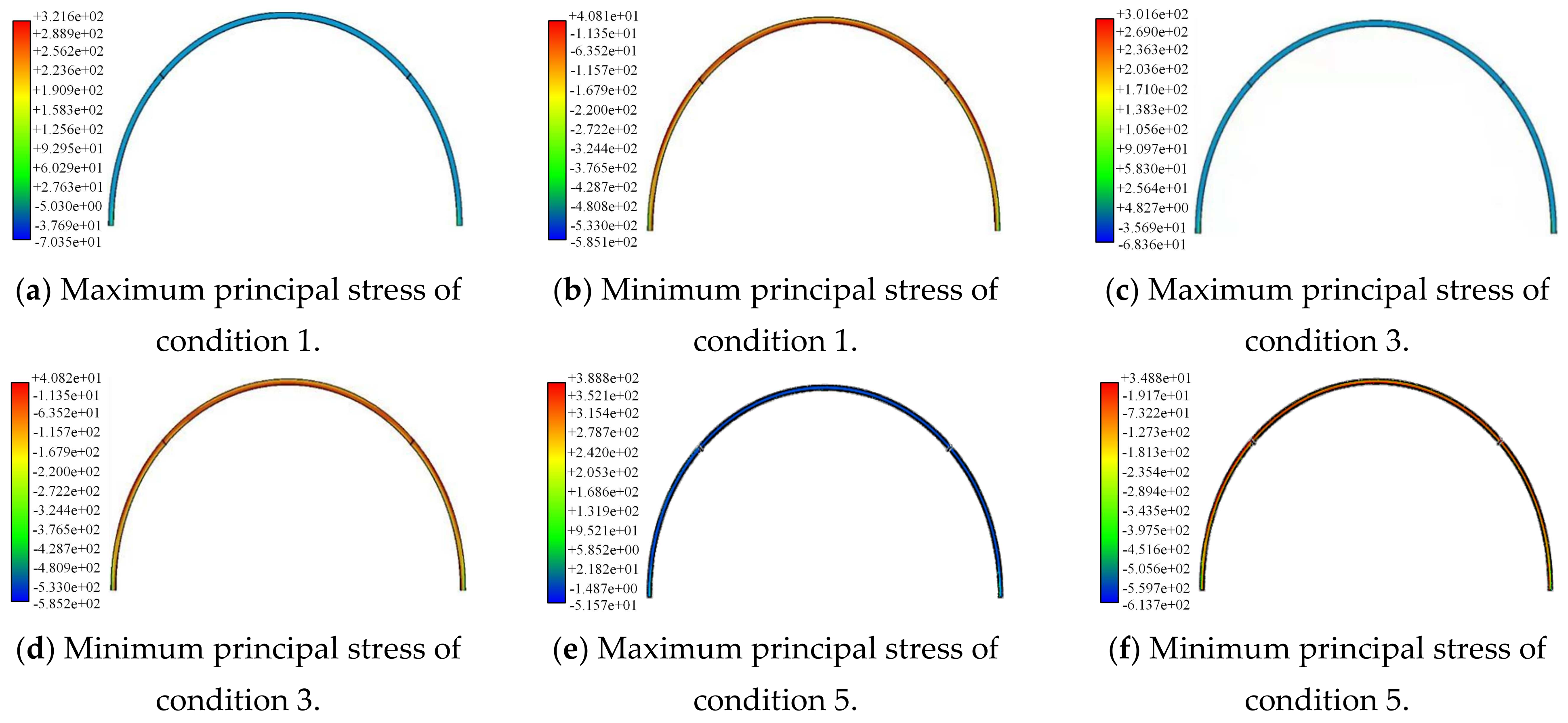



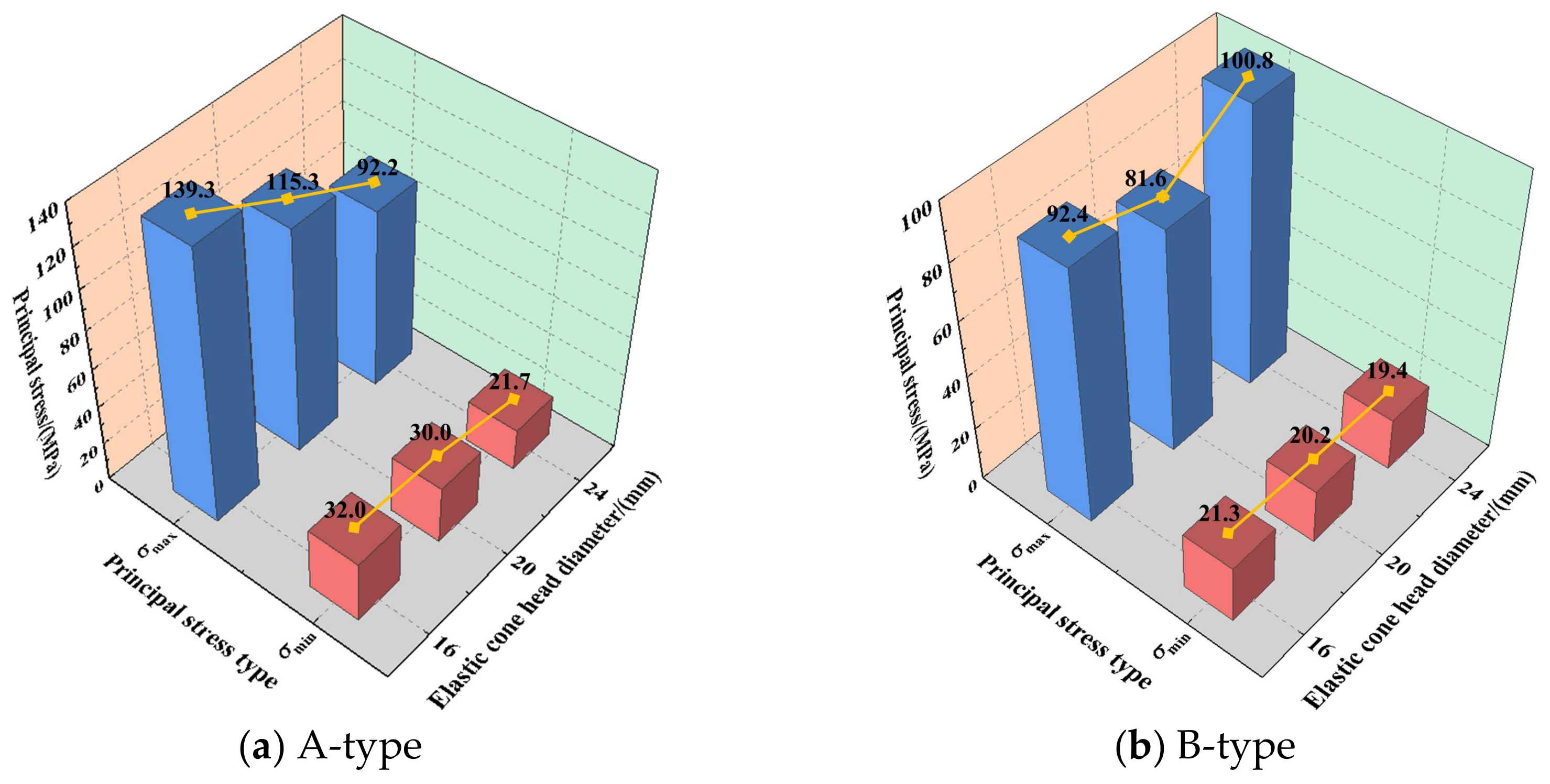



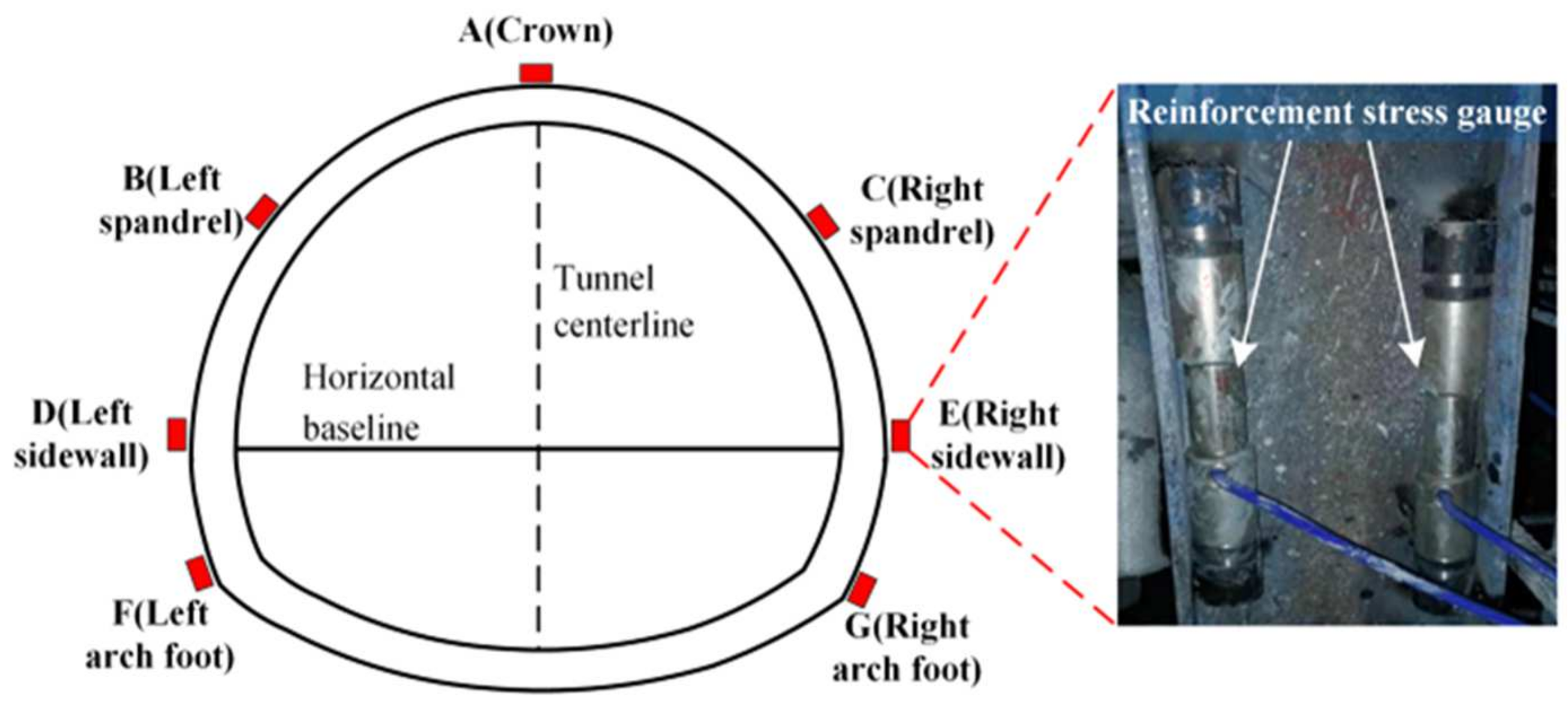
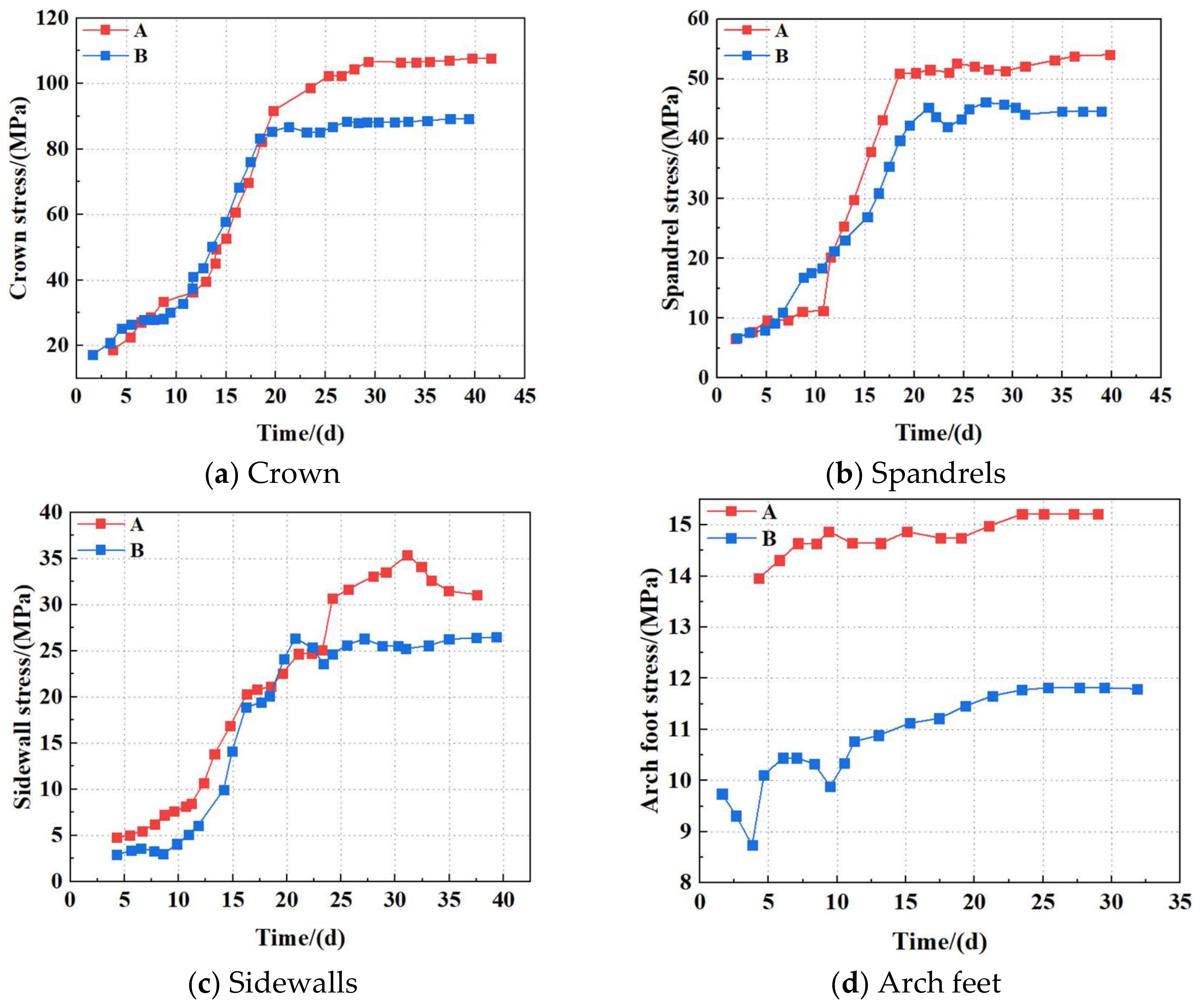

| Snap-Fit Connection | Adhesive Connection | Interference-Fit Assembly Connection |
|---|---|---|
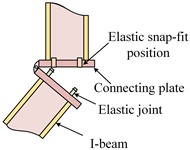 |  | 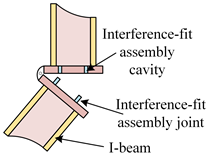 |
 |  |  |
| Simple structure, easy to manufacture, and excellent mechanical performance | Relatively uniform stress distribution but requires waterproof treatment and has a shorter service life | Easy to manufacture but requires high structural dimensional accuracy |
| Component | Material | E/GPa | μ | Sectional Area/cm2 |
|---|---|---|---|---|
| Steel arch frame segments | Q235 | 200 | 0.3 | 26.1 |
| Connecting plate | Q215 | 187 | 0.41 | 58.3 |
| Elastic joint | Q215 | 187 | 0.41 | - |
| Vertical Surrounding Rock Pressure/kPa | Horizontal Surrounding Rock Pressure/kPa | Snap-Fit Connection | ||
|---|---|---|---|---|
| Type | Cone Head Diameter/mm | |||
| 1 | 259.2 | 103.7 | A | 16 |
| 2 | 259.2 | 103.7 | B | 16 |
| 3 | 259.2 | 103.7 | A | 20 |
| 4 | 259.2 | 103.7 | B | 20 |
| 5 | 259.2 | 103.7 | A | 24 |
| 6 | 259.2 | 103.7 | B | 24 |
Disclaimer/Publisher’s Note: The statements, opinions and data contained in all publications are solely those of the individual author(s) and contributor(s) and not of MDPI and/or the editor(s). MDPI and/or the editor(s) disclaim responsibility for any injury to people or property resulting from any ideas, methods, instructions or products referred to in the content. |
© 2025 by the authors. Licensee MDPI, Basel, Switzerland. This article is an open access article distributed under the terms and conditions of the Creative Commons Attribution (CC BY) license (https://creativecommons.org/licenses/by/4.0/).
Share and Cite
Li, S.; Huang, C.; Yang, X.; Tao, Z.; Guo, J.; Li, H.; Yao, T.; Hu, J. Research on the Bearing Characteristics of Folding Steel Arch Frames with Different Snap-Fit Types Based on the Compensation Excavation Concept. Buildings 2025, 15, 1423. https://doi.org/10.3390/buildings15091423
Li S, Huang C, Yang X, Tao Z, Guo J, Li H, Yao T, Hu J. Research on the Bearing Characteristics of Folding Steel Arch Frames with Different Snap-Fit Types Based on the Compensation Excavation Concept. Buildings. 2025; 15(9):1423. https://doi.org/10.3390/buildings15091423
Chicago/Turabian StyleLi, Shaohua, Changfu Huang, Xiaojie Yang, Zhigang Tao, Jiaqi Guo, Humin Li, Tiejun Yao, and Jie Hu. 2025. "Research on the Bearing Characteristics of Folding Steel Arch Frames with Different Snap-Fit Types Based on the Compensation Excavation Concept" Buildings 15, no. 9: 1423. https://doi.org/10.3390/buildings15091423
APA StyleLi, S., Huang, C., Yang, X., Tao, Z., Guo, J., Li, H., Yao, T., & Hu, J. (2025). Research on the Bearing Characteristics of Folding Steel Arch Frames with Different Snap-Fit Types Based on the Compensation Excavation Concept. Buildings, 15(9), 1423. https://doi.org/10.3390/buildings15091423









